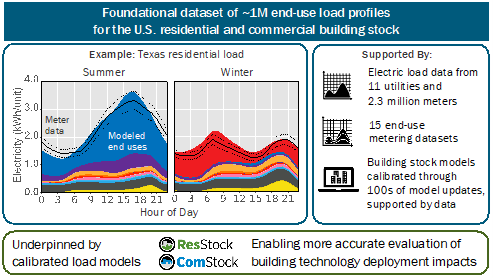by Brianna Crandall — November 1, 2021 — End-use load profiles that describe how and when buildings use energy help utility planners, regulators, state energy offices, researchers, and building owners understand how to best manage energy use. For example, load profiles can identify energy-consuming activities that can be shifted to different times of the day to reduce utility costs customer bills.
 A Department of Energy (DOE) webinar on October 28 introduced a new, publicly available dataset of calibrated and validated synthetic load profiles for U.S. residential and commercial buildings and what it can mean for policy and program design.
A Department of Energy (DOE) webinar on October 28 introduced a new, publicly available dataset of calibrated and validated synthetic load profiles for U.S. residential and commercial buildings and what it can mean for policy and program design.
For several years, researchers have used DOE’s ResStock and ComStock models, developed and maintained by DOE’s National Renewable Energy Laboratory (NREL), to understand building energy use. With support from DOE’s Building Technologies Office, a three-year effort by researchers at NREL, Berkeley Lab, and Argonne National Laboratory calibrated and validated these models at an hourly scale for all major end uses, residential and commercial building types, and climate regions in the United States.
With assistance and guidance from a large technical advisory group, researchers obtained hourly utility meter data from 11 utilities and more than 2.3 million customers, end-use submetering datasets, and other sources. These data were used to inform hundreds of model updates supported by data, which significantly improved the models’ accuracy and usefulness.
The new and improved load profiles will be available in three formats: via a web viewer, as downloadable spreadsheets, and in a detailed format that can be queried with big data tools. Building energy modelers will also be able to access the OpenStudio model input files for their own analyses.
Utilities and others will be able to use these resources — together with tools such as Berkeley Lab’s forthcoming Time-Sensitive Value Calculator — to estimate the value of energy efficiency, demand response, and other distributed energy resources for a wide range of timescales. Such analysis can be used to guide utility resource and distribution system planning, research and development prioritization, and state and local energy planning and regulation.
Additionally, the calibrated models can be a foundation to develop end-use savings shapes that describe the difference in energy consumption between a baseline building and a building with an energy efficiency, electrification, or demand flexibility measure applied.
A report documenting the dataset’s creation, End-Use Load Profiles for the U.S. Building Stock: Methodology and Results of Model Calibration, Validation, and Uncertainty Quantification, will be available in December 2021. To access the dataset when it is released on October 28, visit the project website: End-Use Load Profiles for the U.S. Building Stock.




